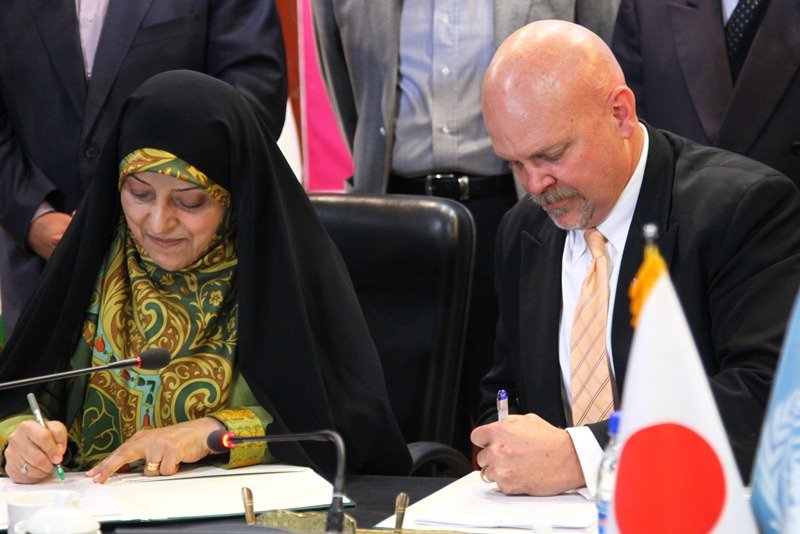Iran, UNDP, Japan sign agreement on the third phase of restoring Lake Urmia

TEHRAN — The third phase of Contribution to Lake Urmia Restoration document was signed on Tuesday in attendance of Masoumeh Ebtekar, chief of the Department of Environment, UN Resident Coordinator and UNDP Representative in Iran Gary Lewis and Japanese charge d'affaires.
In the first phase of the project the Japanese government had contributed $1 million to the UNDP for Lake Urmia.
In March 2014 the Japanese government provided the first grant to UNDP. The contribution was implemented as a component of UNDP's ongoing Conservation of Iranian Wetlands Project, a plan in which UNDP is partnering with Iran's Department of Environment.
Building on the first phase which piloted successful water-saving measures to restore Lake Urmia, the governments of Iran and Japan along with the United Nations signed into effect a project extension (the second phase) in March 2015 which added another $1 million to the combined effort.
In the third phase which has just gone into effect Japan has allocated another $1 million to the project.
Humans have caused the problem for the Lake Urmia and they have to fix it
“We humans have created the problem (for Lake Urmia) and we humans have to fix it and we can and we are,” Lewis noted.
“Lake Urmia is the key wetland of national and global importance which is facing a terrible crisis,” Lewis said. “Due to that the entire basin’s water has been diverted to feed agriculture to produce food and to support livelihood.”
“These are noble goals, but our overconsumption has made the lake to start to dry out,” he highlighted.
He went on to say that “our focus needs to be on the agricultural sector to save water and divert this water back into our thirsty lake and ensure that our farmers livelihood are sustained.”
The United Nations has been engaged with the Iranian government in addressing these problems since 2005, he said, adding since then “Lake Urmia has been one of our first pilot sites and towards the end of this long journey of progress for the last three years we joined another friend, Japan.”
“Japan is known as a pioneer country in addressing all forms of global development challenges and today by signing this agreement which will release another US$1 million from the government of Japan we enter the third year of implementation of our pilot plan in East and West Azarbaijan provinces,” he explained.
Here are some of the strategic achievements that have been made during these years:
“We have covered a total number of 75 villages in our work to date and while doing this we have covered an agricultural footprints of 50,000 hectares; we have saved about one third of water (at least 35 percent) in the areas we have worked, and finally we managed to reduce the use of chemicals by about 40 percent and in some farmlands we managed to reduce the use of these chemicals to zero.
“I believe what we have achieved together is a remarkable result and yet this intervention represents only about five percent of the total agricultural coverage of Lake Urmia’s basin.”
Restoration through engaging local community and farmers
This project specifically addresses the restoration of the lake mainly through engaging local community and farmers by applying sustainable agriculture techniques, said Mohsen Soleimani Rozbehani, director of the international project of wetlands conservation.
Out of 250 villages located within the lake basin ecological zone the first phase of the project was initiated in 41 villages around the basin of the lake, Soleimani Rozbehani said.
The second phase aimed at promoting sustainable agriculture and reducing water consumption in the farming communities adjacent to the saltwater lake by engaging local community and farmers to use a technique called Integrated Participatory Crop Management (IPCM), he explained.
The second scaled-up phase of the project expanded to cover an additional 34 villages, he added.
This technique resulted in water saving of at least 35% which, in turn, will allow the saved water to return to the lake, thus replenishing it and at the same time, he explained.
The project emphasized a reduction in use of fertilizer chemicals which will also ensure more environmental sustainability, he added.
He additionally said that 8,000 farmers and 12 local NGOs participated in fulfilling the plan voluntarily.
Iran spent $430 million to revive Lake Urmia in past year
For her part, Ebtekar said that during the past year (March 2015-March 2016) Iran spent 15 trillion rials (nearly $430 million) in line with the program to restore the lake.
Japan’s contribution to this project, she said, indicates the international importance of the lake.
Lake’s water level has increased 9 centimeters
Compared to the same time last year Lake Urmia’s water level has risen about 9 centimeters, chief of the Department of Environment for West Azarbaijan said.
Parviz Arasteh expressed hope that with the coming rainfalls in this year the lake would stretch over 3,000 kilometers.
More snowfalls, low temperature, dredging of the rivers at the lake basin for 41 kilometers and soil moisture has all contributed to the rise of the lake water level, he explained.
MQ
Leave a Comment